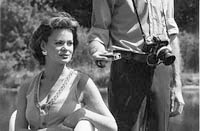Ok, you've decided to take the plunge and buy a digital camera. Or perhaps you already own one and are considering upgrading to a better model. Either way, you may be intimidated by the bewildering array of choices out there. So what do you do?
First of all, keep in mind there are two basic types of digital — Digital Single Lens Reflexes (DSLR's for short) and smaller compact models, commonly referred to as "point-and-shoots". DSLR's offer interchangeable lens capability, true through-the-lens viewfinders, fast operation, and generally low digital noise. If you currently own a 35mm SLR you'll find the transition to a DSLR relatively painless and in fact you may be able to use lenses you already have. Canon EF lenses will work just fine on any Canon digital, ditto for Nikon, Minolta, and Pentax lenses originally designed for their 35mm models. However, some lenses may not have full functionality on the digital body.
DSLR's are the preferred choice of professional photographers everywhere, especially photojournalists, so buying one is a "no brainer", right? Well, there are downsides to consider. Let me mention one in particular, something you won't find in every digital camera guide, digital's "dirty little secret" — dust on the sensor. Every time you change lenses you expose the interior of the camera to the outside environment. Many users habitually point the camera down when changing lenses in the hope that such a position will minimize the chances of dust blowing into the interior. But what's the big deal? You can just use one of those sensor cleaning brushes or a blower (better not use canned air for the latter; the propellant might get on the sensor) and the problem is gone. Or is it? How serious a problem is sensor dust? Well, if you often shoot at wide apertures you may not even see it. Also, it's more likely to be noticeable in areas of uniform density on the image, like clear sky, rather where you have lots of busy detail. Dust specs will likely be more visible on large prints. If you mostly make 4 x 6 inch prints, you can probably forget about it. Finally, the dust specs can be easily spotted out in Photoshop or other image editor but keep in mind those specs will be on every single frame as long as the dust is there. As someone who spent countless hours spotting Kodachrome scans (ICE, that wonderful dust and scratch removal program, doesn't work on most Kodachrome) I can tell you it's no fun.
Sensor dust (the dust is not on the sensor itself but rather on a filter in front of the sensor) is a fact of life when using a DSLR. So far only one manufacturer has developed technology to deal with this — Olympus. All their DSLR's come equipped with what Olympus calls the Ultrasonic Wave Filter which shakes off the dust (it's supposed to fall onto a piece of sticky material below the sensor). Users I have spoken to stated that this feature worked just fine.
I don't want to belabor this dust issue with DSLR's. These cameras offer compelling reasons to purchase them rather than a point-and-shoot. And the cost, at least for entry-level models, has fallen dramatically over the last year or two. For example, the Nikon D50 with an 18-55mm lens retails for about $650 as of this writing. Canon, Olympus, and Pentax offer similar models with a lens for under $1000 and all these cameras are quite capable of high-quality results.
But what about point-and-shoot cameras? Well, if you want something small that can be slipped into a pants or jacket pocket, these little beauties are the only way to go. (I'm not discussing camera phones here. They're fun but I consider them to be toys, at least at this stage in their development, not "serious" imaging tools). Point-and-shoots themselves break down into two types – those with electronic viewfinders (EVF's) and those equipped with optical ones (actually there's a third type – those that feature only an LCD monitor). The latter viewing systems should not be confused with through-the-lens SLR's. They are not remotely similar. The expression "tunnel vision" vividly describes the tiny and cramped view typical with the optical point-and-shoots. And they usually don't display any camera information like shutter speed and f/stop. You must access that info via the LCD monitor. The most you see in the optical viewfinder is an autofocus indicator. There's a heavy crop factor too which is one reason to frame your subject with the LCD monitor on these models whenever practical. The EVF's on the other hand generally show all the information that is normally visible on the camera's monitor. That's very handy when very bright conditions make it difficult (or impossible) to see what the monitor is displaying.
To continue with our digital camera guide, the big "plus" with the point-and-shoot models is "live preview". You see the visual effect of exposure and white balance settings BEFORE you take the picture. Very nice. With DSLR's these things are only visible in Playback mode (an exception apparently is the new Olympus E330). And you can compose and shoot while looking at the image on the LCD monitor, which often flips out and rotates for a more comfortable viewing position. Then too, sensor dust is not usually an issue with these since the lens doesn't come off. What more could you want? But what about the "minuses"? Well, there are plenty of them. Excessive noise, especially at the higher ISO settings, for one, largely a consequence of the tiny sensors (the new Sony Cybershot DSC-R1 sports a larger one and may perform better, noise-wise). The 8MP models are arguably the worst in this regard though they are fine at 100 ISO. Of course, you can apply a noise reduction program like Neat Image, Dfine, or Noise Ninja but noise reduction, whether post capture or in-camera, inevitably entails some softness and loss of detail. It's a bit of a trade-off.
Another tradeoff is operating speed. Compared to DSLR's they are really sluggish, especially in burst (sequence) mode or when shooting RAW. Combine these two shooting modes and you may have enough time to make a phone call while you wait! The cameras typically lock up (meaning you can't take any pictures) while the images are processed and written to the memory card. For example, the Olympus C8080, an otherwise fine camera, takes up to a minute and a half to process RAW files when shooting in burst mode. As for "tunnel vision", the EVF's exhibit this too because of low viewfinder magnification (so do some SLR's, digital or film, for that matter), though the display is usually close to 100% of what the sensor is capturing. But the brightness and clarity you see in an SLR's viewing system simply isn't there in an EVF. Speaking of monitors, larger ones are all in vogue this year with the size champ currently on the Samsung Pro 815 – 3.5 inches. This camera also comes equipped with a very long-range zoom lens, 28-420mm (35mm equivalent) but sadly no image stabilization.
By the way, let me insert a word of warning here. If you are new to digital, don't be misled by claims that the better EVF's are "SLR-like". That's marketing baloney floated by certain manufacturers. In no way are the EVF's comparable to SLR's.
Is lens interchangeability important to you? Then forget the point-and-shoot models. Want to capture sports or other fast action? Then get a DSLR. The response time of the point-and-shoots is way too slow for those subjects. In fact, is there ANY reason to buy a point-and-shoot unless you want something that will fit in your pocket? After all, the better EVF's are not small and not light. The Sony Cybershot DSC-R1, for example, weighs in at over two pounds (995g). On the other hand, the Sony Cybershot DSC-T7 weighs only 4.1 oz (115g), a little more when you add a battery and memory card. Naturally the DSC-T7 doesn't have anywhere near the capability of its heavier brother, the R1, but it's definitely pocketable. Well, as always, buying a camera depends on two factors: your needs (or maybe desires) and your budget.
Going pro or already one? Then the only decision is which DSLR to get and that brings the second factor, budget, into play. Can you afford the really high-end models like the Nikon D2X or the Canon 1Ds MK II? Pro bodies like these have dust and moisture seals over the camera's seams, use lubricants that last longer and operate over a wider temperature range, and are probably subjected to more stringent quality control in their construction. They will generally stand up to heavy professional use. They contain less plastic too as the bodies are commonly made of magnesium alloy or something similar. If you need those refinements, great. Otherwise, one of the less costly models like the Canon 20D or the new Nikon D200 will likely do just as well. Still too expensive (the D200 currently sells for $1700, body only)? Nikon, Canon, Olympus, and Pentax offer many less expensive choices. And if you happen to have a bunch of Minolta Maxxum lenses, don't discount the Konica-Minolta 7D or 5D. That brand name may be disappearing from the camera scene (you can read about it on this Web site) but those cameras measure up and feature K-M's version of image stabilization — right in the camera body.
If all this sounds like I am recommending that you purchase a DSLR rather than an EVF, I am. The latter are sometimes just as expensive as the former so you don't necessarily save money by going the EVF route. I still use an EVF and I know there are new models on the market. But I feel that EVF's day has passed. Camera phone anyone?
If you have the digital camera that is right for you, take a look at our digital photography course to take your photos to the next level.






